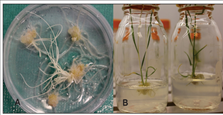Kanamycin in Cereal Biotechnology: A Screening or a Selectable Marker?
Abstract
 Abstract Views: 397
Abstract Views: 397
Kanamycin is a widely used selection agent in dicot-plant genetic transformation systems. In monocots, however, it does not seem to be effective as it has no or minimal effect on the normal growth of non-transformed plants. Kanamycin was previously demonstrated to bleach the pigments of the non-transgenic plants. This may yield the idea that kanamycin can be used as an effective screening marker rather than a selectable marker in monocots.
Copyright (c) 2021 Malik Nawaz Shuja, Hasan Riaz, Muhsin Jamal, Muhammad Imran
Downloads
References
Kors FT. Antibiotics: mode of action, spectrum, resistance, solubility, sterilization, stability. Hareelm: Duchefa:1993;1-30.
Nap JP, Bijvoet J, Stiekema WJ. Biosafety of kanamycin-resistant transgenic plants." Transgenic Research. 1992;1(6):239-49. DOI: https://doi.org/10.1007/BF02525165
Benveniste RA, Davies J. Mechanisms of antibiotic resistance in bacteria. Annu Rev Biochem. 1973; 42:471-506. DOI: https://doi.org/10.1146/annurev.bi.42.070173.002351
1146/annurev.bi.42.070173.002351
Brasileiro AC. Neomicina Fosfotransferase II (NPT II). Manual de transformação genética de plantas. Embrapa-Cenargen, Brasília;1998:143-54.
Bevan MW, Flavell RB, Chilton MD. A chimaeric antibiotic resistance gene as a selectable marker for plant cell transformation. Biotechnol. 1992; 24:367-370.
Fraley RT, Rogers SG, Horsch RB, et al. Expression of bacterial genes in plant cells. Proc. Natl. Acad. Sci. 1983;80(15):4803-7. https://doi.org/10.1073/pnas.80.15.4803 DOI: https://doi.org/10.1073/pnas.80.15.4803
Herrera-Estrella L, De Block M, Messens EH, et al. Chimeric genes as dominant selectable markers in plant cells. EMBO J. 983;2(6):987-995. https://doi.org/10.1002/j.1460-2075.1983.tb01532.x DOI: https://doi.org/10.1002/j.1460-2075.1983.tb01532.x
Norelli JL, Aldwinckle HS. The role of aminoglycoside antibiotics in the regeneration and selection of neomycin phosphotransferase-transgenic apple tissue. J Am Soc Hortic Sci. 1993;118(2):311-316. https://doi.org/10.21273/JASHS.118.2.311 DOI: https://doi.org/10.21273/JASHS.118.2.311
Weide R, Koornneef M, Zabel P. A simple, nondestructive spraying assay for the detection of an active kanamycin resistance gene in transgenic tomato plants. Theor Appl Genet.1989;78(2):169-172. DOI: https://doi.org/10.1007/BF00288794
Potrykus I, Saul MW, Petruska J, et al. Direct gene transfer to cells of a graminaceous monocot. Mol Gen Genet. 1985;199(2):183-188. DOI: https://doi.org/10.1007/BF00330257
Hauptmann RM, Vasil V, Ozias-Akins P, et al. Evaluation of selectable markers for obtaining stable transformants in the Gramineae. Plant physiol. 1988;86(2):602-606. DOI:
https://doi.org/10.1104/pp.86.2.602 DOI: https://doi.org/10.1104/pp.86.2.602
Dekeyser R, Claes B, Marichal M, et al. Evaluation of selectable markers for rice transformation. Plant Physiol. 1989 ;90(1):217-23. DOI: https://doi.org/10.1104/pp.90.1.217
Zhang HM, Yang H, Rech EL, et al. Transgenic rice plants produced by electroporation-mediated plasmid uptake into protoplasts. Plant Cell Rep. 1988;7(6):379-84.
He Y, Jones HD, Chen S, et al. Agrobacterium-mediated trans-formation of durum wheat (Triticum turgidum L. var. durum cv Stewart) with improved efficiency. J Exp Bot. 2010;61(6):1567-1581. https://doi.org/10.1093/jxb/erq035 DOI: https://doi.org/10.1093/jxb/erq035
Assem SK, Hussein EH, Hussein HA, et al. Genetic transformation of the Nicotiana protein kinase (NPK1) gene confers osmotic tolerance in Egyptian maize. Aust J Basic & Appl Sci. 2009;3(2):828-835.
Omirulleh S, Ábrahám M, Golovkin M. Activity of a chimeric promoter with the doubled CaMV 35S enhancer element in protoplast-derived cells and transgenic plants in maize. Plant Mol Biol. 1993;21(3):415-28. DOI: https://doi.org/10.1007/BF00028800
Peters NR, Ackerman S, Davis EA. A modular vector for Agrobacterium mediated transformation of wheat. Plant Mol Biol Rep. 1999;17(4):323-331. DOI: https://doi.org/10.1023/A:1007686408369
Öz MT, Eyidoğan F, Yücel M, et al. Optimized selection and regeneration conditions for Agrobacterium-mediated transformation of chickpea cotyledonary nodes. Pak J Bot. 2009;41(4):2043-54.
Ali M, Tahir M, Hameed S.Genetic transformation of an elite commercial wheat variety through Agrobacterium tumefaciens. Int J. Biosci. 2016;8(1):17-24. DOI: https://doi.org/10.12692/ijb/8.1.17-24
Ali M. Engineering resistance against barley yellow dwarf virus (BYDV) by expression of the virus derived gene(s) in a model plant. PhD Dissertation. Atta-ur-Rahman School of Applied Biosciences. National University of Sciences and Technology, Islamabad, Pakistan; 2017.

Copyright (c) 2021 Malik Shuja

This work is licensed under a Creative Commons Attribution 4.0 International License.
BSR follows an open-access publishing policy and full text of all published articles is available free, immediately upon publication of an issue. The journal’s contents are published and distributed under the terms of the Creative Commons Attribution 4.0 International (CC-BY 4.0) license. Thus, the work submitted to the journal implies that it is original, unpublished work of the authors (neither published previously nor accepted/under consideration for publication elsewhere). On acceptance of a manuscript for publication, a corresponding author on the behalf of all co-authors of the manuscript will sign and submit a completed the Copyright and Author Consent Form.









